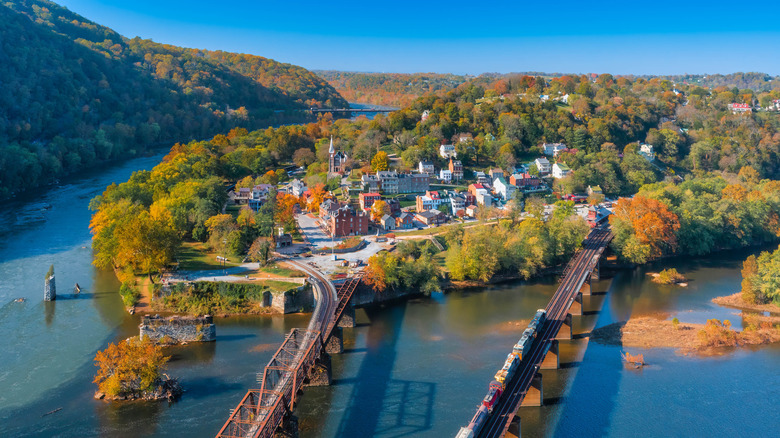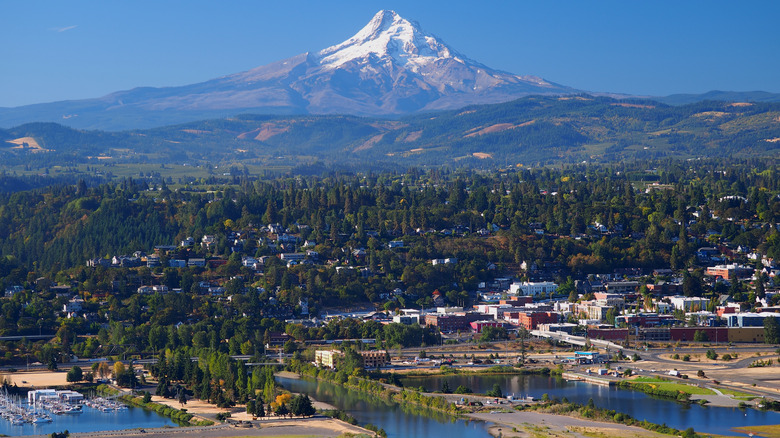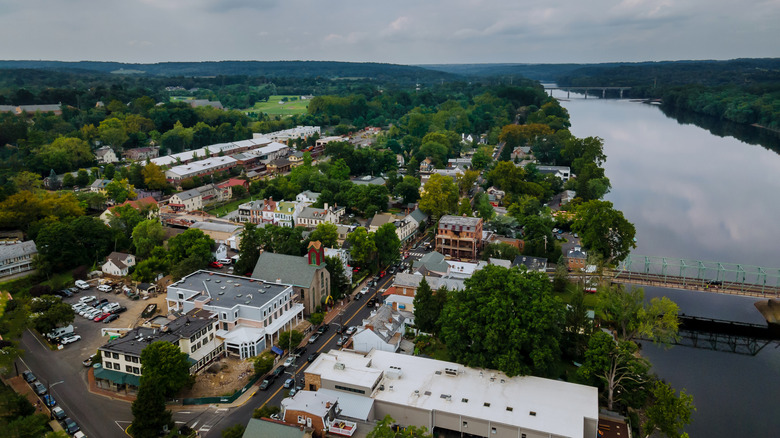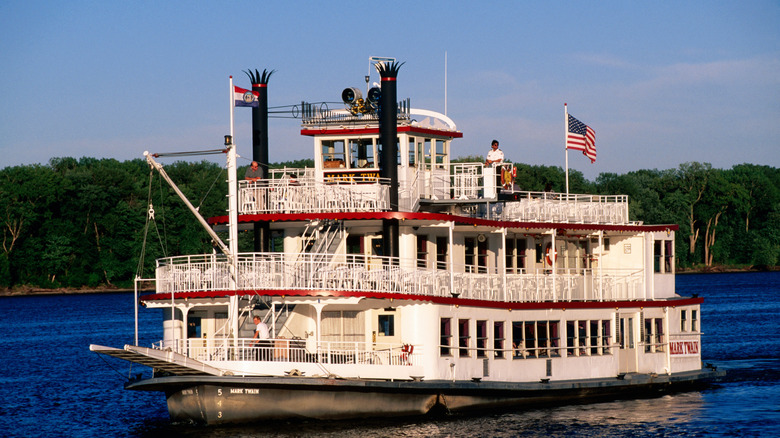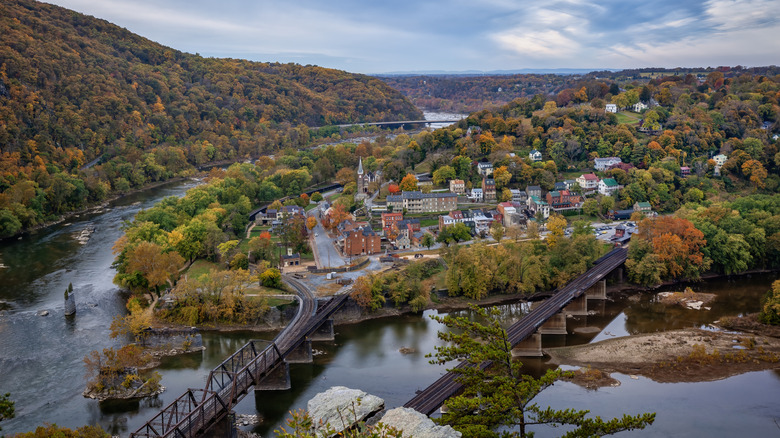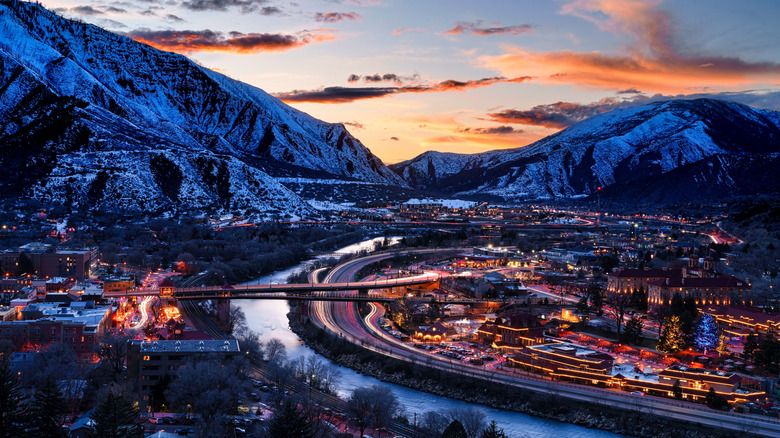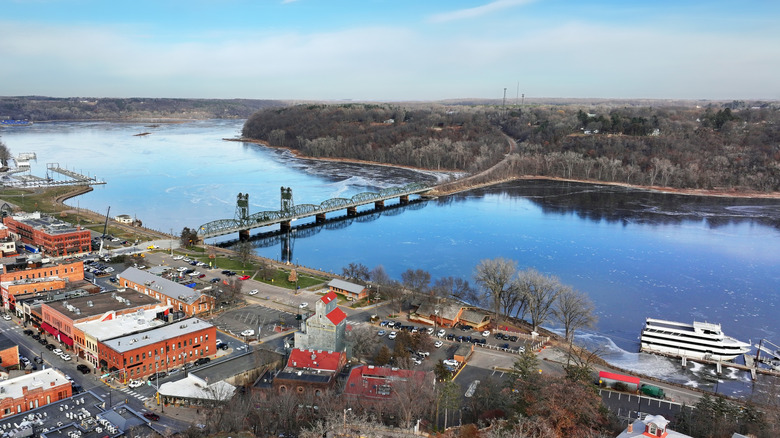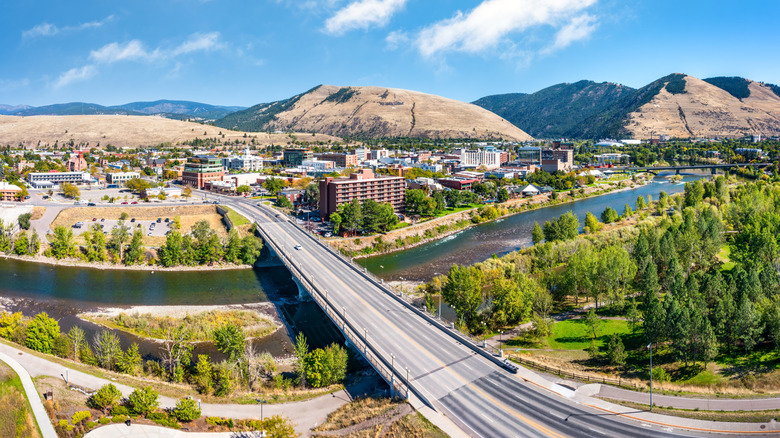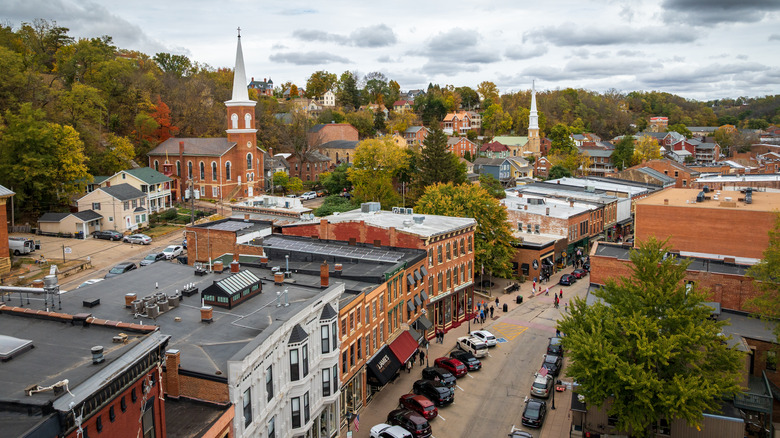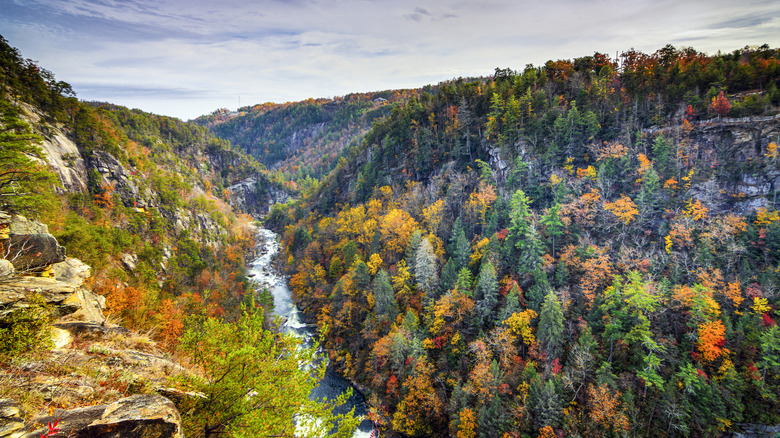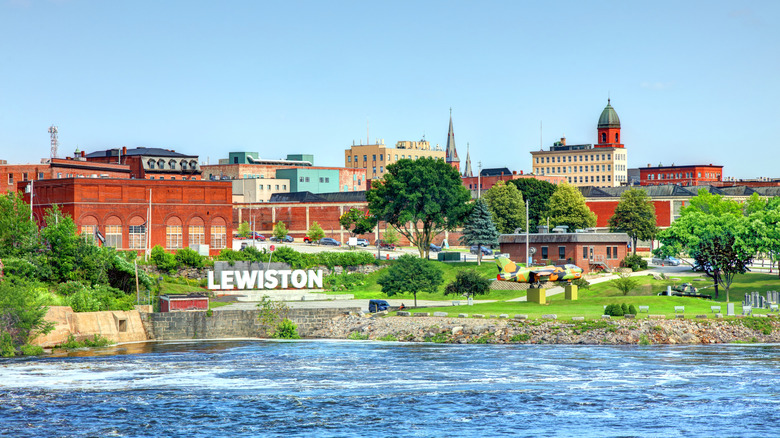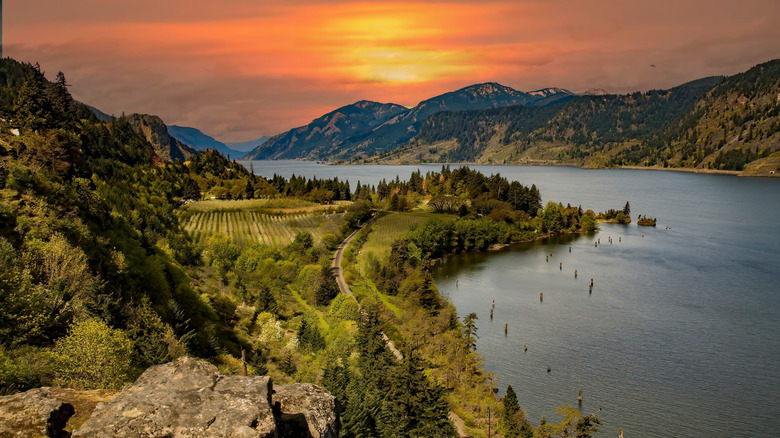These Are America's Most Charming River Towns That Blend Small-Town Charm With Stunning Scenery
From watching the morning mist rising over the water to seeing kayaks gliding past historic bridges and cobblestone streets on the waterfronts, America's river towns can easily sweep you away. The United States is home to more than 250,000 rivers, and these waterways have played a vital role in not only shaping the very terrain of the country but also fueling commerce, leisure, and culture. Along their banks, towns have grown that are rich in history, architectural charm, and jaw-dropping natural beauty.
With water snaking through their centers or against backdrops ranging from verdant valleys to snow-capped peaks, river towns offer countless opportunities for both leisure and adventure. From a small port nestled in the mountains of the Pacific Northwest to a Colonial-era village in the leafy Northeast, these river towns boast the perfect mix of stunning waterways, small-town charm, and breathtaking scenery to offer the ideal getaway from busy life.
Hood River, Oregon
Hood River sits on a port in the heart of the panoramic Columbia River Gorge, at the confluence of the majestic Columbia River and the Hood River tributary. It offers sweeping views of the surrounding Cascade Mountains and is located just shy of 40 miles north of Mount Hood, making it an ideal day trip for visitors to Oregon's tallest peak. In Hood River, towering mountains meet rolling water and lush forests, offering opportunities for everything from thrill-filled outdoor adventures to leisurely strolls through the town.
This picturesque Oregon city with magical mountain views has been dubbed the "Windsurfing Capital of the World," thanks to how the Columbia River Gorge creates a natural wind tunnel, offering ideal conditions for seasoned windsurfers and beginners alike. On sunny days, you can catch the brightly colored sails of windsurfers and kite surfers slicing through the water. Windsurfing is only one of myriad water sport activities in Hood River. Outdoor enthusiasts can also go kayaking, paddleboarding, or whitewater rafting to take full advantage of all that the mighty Columbia has to offer.
There are also plenty of land-bound activities to do, with every season in Hood River bringing its own charms. Springtime beckons a rainbow of wildflowers, with swathes of blossoms covering the hills. The warmer months also provide the perfect opportunity to check out the many scenic hiking trails and tumbling waterfalls that wind throughout the Columbia River Gorge. The Hood River Valley Festival takes place every autumn, bringing fun for all ages, including art vendors, live music, food carts, and of course, local libations from the area's famed wineries and cideries. Visitors will also want to set aside time to check out the town's charming downtown district, which is lined with boutique shops, restaurants, and galleries.
New Hope, Pennsylvania
Nestled on the banks of the Delaware River just over an hour from both Philadelphia and New York, this artsy enclave feels worlds away from the hustle and bustle of city life. As a child growing up in Philadelphia, visiting New Hope was one of the highlights of my autumns, and I can still remember the crunch of leaves and smell of the changing air as I wandered the cobblestone sidewalks of Main Street. Visitors from across the Northeast flock here annually to take in the vibrant fall foliage.
The Delaware River is central to the town's charm, providing stunning views and abundant recreation opportunities, including kayaking and canoeing. The 60-mile Delaware Canal Towpath is a Registered Historic National Landmark that dates back to the 19th century. It offers a step back in history, following the same path once used by mule-drawn barges carrying coal and goods. Today, the towpath is a peaceful, shaded trail that provides the perfect backdrop for romantic strolls, brisk hikes, and scenic bike rides, with views of both the river and town.
New Hope was first settled in 1715 as Wells' Ferry and it retains much of its colonial-era appeal, with cobblestone streets and historic architecture. Throughout its history, the town has become a haven for painters, writers, and actors, now serving as a regional hub for arts and culture. New Hope's Main Streets features galleries, bohemian boutiques, riverside restaurants, and the iconic Bucks County Playhouse — a former gristmill converted into a theatre space, just steps away from the Delaware River. Since its founding in 1939, legends such as Grace Kelly, Robert Redford, Liza Minelli, Angela Lansbury, Bob Fosse, and many more have graced its storied stage.
Hannibal, Missouri
Hannibal sits on the banks of the mighty Mississippi, and this quaint river town invites visitors to take a trip back in time. Known as the childhood home of beloved author Samuel Langhorne Celemens, better known as Mark Twain, the historic town is a must-see for fans of American literature. Here, you can check out the landscapes that inspired some of Twain's most legendary works, while the Mark Twain Boyhood Home & Museum features first editions of Twain's manuscripts, personal childhood artifacts, and the iconic whitewashed fence immortalized by Tom Sawyer's adventures.
With its unique blend of history, natural beauty, and leisure, Hannibal has much to offer beyond its literary heritage. Visitors can board the Mark Twain Riverboat Cruise to spend an evening of storytelling and scenery that recalls the golden age of paddle steamers. Hannibal is also home to more than 20 parks, including the 465-acre Riverview Park, which offers walking and biking trails, historic statues, and a spectacular overlook of the Mississippi. The town is framed by wooded bluffs and rolling hills, offering plenty of opportunities to sit back and enjoy the landscape.
On a recent road trip, I found myself charmed by Hannibal's lush riverbanks, 19th-century architecture, and surprisingly hip downtown district, and ended up spending several days in town after intending for just an overnight visit. Every business in downtown Hannibal is locally owned, and it was incredibly easy to spend the afternoon wandering the boutique shops and restaurants in their beautifully restored buildings. Big Muddy BBQ is a major favorite, with a simple but mouthwatering menu of regional favorites.
Harpers Ferry, West Virginia
Perched at the picturesque confluence of the Potomac and Shenandoah rivers where Maryland, West Virginia, and Virginia meet, Harpers Ferry is one of the most important towns in American history and a West Virginia gem with timeless natural beauty. This small town of under 400 residents is best known as the site of John Brown's 1859 raid, which was a turning point in the abolitionist movement. History buffs can flock to the Harpers Ferry Natural Historic Park to take a glimpse at this pivotal moment in history through preserved 19th-century buildings and interpretive exhibits.
The National Historic Park also features more than 20 miles of hiking trails. Visitors won't want to miss The Point, which offers a view of where the Potomac and Shenandoah rivers meet. Another favorite is the Maryland Heights Trail, which is part of both the Appalachian Trail and historic C&O Canal Path and features several important Civil War sites. Hikers on this moderate to strenuous trail are also rewarded with the Maryland Heights Overlook, offering one of the most iconic views on the East Coast — a picture-perfect vista featuring both the confluence of the two rivers and town of Harper's Ferry itself. For especially jaw-dropping views, visit in autumn to take full advantage of the fall foliage.
The town of Harpers Ferry is just as captivating as its scenery. Historic Lower Town is lined with cobblestone streets and preserved buildings, some dating back to the 18th century. Quaint churches, small museums, antique shops, and colonial architecture give the village an almost storybook feel. After a day of historic sightseeing or hiking, visitors can grab a bite at the popular gastropub The Rabbit Hole, which offers local cuisine and an extensive beer list.
Glenwood Springs, Colorado
Up in the snow-capped peaks of the Centennial State, where the Roaring Fork River meets the Colorado River, sits one of America's best hot spring towns that feels like an Icelandic escape. Dubbed Colorado's "Land of Water," the town's two rivers and three hot springs make it the perfect place to enjoy everything from a thrill-filled day of outdoor recreation to a romantic evening in geothermal bathing bliss.
The scenery in Glenwood Springs is nothing short of cinematic, with the 16-mile Glenwood Canyon featuring towering walls, cascading waterfalls, and forested slopes. Cutting through the center of it all is the mighty Colorado River, which shaped this dramatic landscape over 3 million years. Today, visitors to the river can traverse Class III rapids, fly fish in its Gold Medal waters, drift along calmer stretches for a scenic float, or watch for wildlife on the riverbanks.
No trip to Glenwood Springs is complete without a visit to at least one of the town's hot springs. Glenwood Hot Springs Resort is home to the world's largest hot springs pool, sourced from the Yampah Spring, which delivers more than 3 million gallons of mineral-rich water each day. Iron Mountain Hot Springs offers an even more intimate experience, with a series of terraced pools set along the riverfront, each with dramatic Rocky Mountain views. The Yampah Spa and Vapor Caves is the only natural vapor cave in North America, inviting visitors to soak in subterranean steam baths.
Despite its dramatic backdrop, Glenwood Springs retains a small-town character. Its historic downtown is highly walkable, with outdoor suppliers, bookshops, cozy cafes, and riverfront restaurants, where diners can listen to the roaring water as the sun sets behind the canyon cliffs. It's the ideal place for adventure, relaxation, romance, and some homespun charm.
Stillwater, Minnesota
Located just 30 minutes northeast of Minneapolis, Stillwater is a picturesque, artsy city with a lively food scene and historic downtown. Dubbed the "Birthplace of Minnesota," Stillwater is one of Minnesota oldest and most charming cities. It played a central role in the establishment of the state and vestiges of its past remain to this day, including Victorian homes and preserved mills.
The town sits on the tranquil banks of the St. Croix River, which was designated a National Scenic Riverway by the National Park Service thanks to its natural beauty and rich diversity of flora and fauna. There's plenty for visitors to do on the majestic waterway, including taking a romantic ride on a Venetian gondola, renting a stand-up paddleboard, or embarking on a dinner cruise on a historic paddle-wheel boat with Stillwater River Boats. The two-hour excursions feature stunning views of Stillwater and the St. Croix, including the town's iconic Lift Bridge and the lush forests that line the riverbanks. For an even more panoramic perspective, visitors can soar above the entire St. Croix River Valley with Stillwater Balloons, taking in the full sweep of winding river bends.
Back on land, Teddy Bear Park is a favorite for families with young children thanks to its unique playgrounds and quiet spots to sit and watch the river. Downtown Stillwater boasts brick-lined streets with boutique shops, galleries, and cafes. For foodies, Stillwater has become a haven within the Midwest, having been named among the 10 best small town food scenes by USA Today. From the popular duck bacon wantons at the Brick & Bourbon to craft cocktails at Mad Capper Saloon & Eatery, visitors can happily eat and drink their way down historic Main Street.
Missoula, Montana
Missoula is nestled between five valleys, at the convergence of the Clark Fork, Bitterroot, and Blackfoot Rivers. Here, the rugged Rockies meet a thriving cultural scene, making the town a mecca for outdoor enthusiasts and artists alike. Missoula is home to the University of Montana, which gives the town a vibrant college town feel, but it has so much to offer beyond the university.
There's no shortage of recreation opportunities for enjoying Missoula's waterways, with the riverfront trail system inviting anglers, kayakers, and tubers to enjoy the snaking Clark Fork. The iconic "M" on Mount Sentinel watches over the town, and is a hiking destination in itself, offering panoramic views of the rivers and valleys below. Missoula is also an ideal destination for birding, with an abundance of owls, tanagers, wrens, hawks, and other winged residents calling the surrounding Northern Rockies their home.
Downtown Missoula pulses with campus life, a vibrant arts scene, and buckets of small-town charm. Just south of the Clark Fork River and east of Higgins Avenue sits the "Hip Strip" district. On the Hip Strip, historic architecture meets one-of-a-kind boutiques, galleries, eateries, and the iconic Roxy Theater, a nonprofit and community-owned cinema with a retro facade.
Galena, Illinois
Bursting with cozy inns, local wineries, and historic charm, Galena is a top Illinois getaway. The town of just under 3,000 residents is located on the Galena River, a branch of the Mississippi. The town is named after the mineral galena, which was central to the mining economy that made Galena a bustling port and steamboat hub in the 1880s.
While today Galena enjoys a slower pace of life, its historic character remains, with an impressive 85% of the city listed in the National Register of Historic Places. Known as the Galena Historic District, this area features over 1,000 properties constructed before 1900 and offers visitors a step back in time.
Built on an old railroad spur, the Galena River Trail allows for hiking, biking, and snowshoeing past wetlands and limestone bluffs. With the river meandering its center, downtown Galena has a storybook quality. You can step back in time along Main Street, with more than 125 shops and restaurants, each inside exquisitely preserved historic buildings. "This is the real thing," said Galena historian Steve Repp to Smithsonian Magazine. "There have been only cosmetic changes, nothing more, since the 1860s."
Tallulah Falls, Georgia
With under 300 residents, Tallulah Falls may be small — but what it lacks for in size, it makes up for in scenic grandeur. This quaint town sits along the Tallulah River, which meanders through the landscape to carve the spectacular Tallulah River Gorge. Two miles long and nearly 1,000 feet deep, the dramatic chasm offers some of the most jaw-dropping views in the Eastern United States.
One of the biggest highlights of Tallulah Gorge State Park are the waterfalls that give the town its namesake. Rather than a single waterfall, Tallulah Falls is a series of six falls that rush through the gorge. Suspension bridges, scenic overlooks, and a seemingly endless series of stairs allow visitors to wander through the majestic landscape, taking in the dizzying views, dense forest, and whitewater rushing below.
The town of Tallulah Falls was a booming tourist resort in the 1880s, earning it the nickname "Georgia's Niagara of the South." Today, downtown Tallulah Falls retains much of its historic charm. Visitors can grab a cup of brew before their morning hikes at Tallulah 1882, a cafe tucked inside a historic train station, or check out the General Store for souvenirs and treats.
Lewiston, Idaho
Situated in the Lewis Clark Valley, Lewiston is a charming Idaho town at the intersection of two rivers that is teeming with history and scenic trails. It offers rugged beauty paired with small-town charm, offering riverside parks, historic architecture, and plenty of opportunities for thrill-seeking. Named after Meriwether Lewis of the famed Lewis and Clark expedition, Lewiston offers a glimpse into both indigenous history and early American exploration.
The town sits at the confluence of the Snake and Clearwater Rivers, and serves as a gateway to Hells Canyon National Recreation Area, the deepest river gorge in North America. Outdoor adventurers can enjoy all that the canyon has to offer with whitewater rafting, kayaking, jet boat tours, fly fishing, and more. Those looking for a more laidback experience can walk or bike the miles of riverside trails.
The Nez Perce National Historic Park offers insights into the region's Native American history, while the Lewis & Clark Discovery Center provides interactive exhibits detailing the explorers' journey through the area. After a day of hiking and history, visitors can spend a tranquil evening strolling along Lewiston's scenic riverfront, enjoying views of the two rivers as the sun sets behind the surrounding hills. Downtown Lewiston brims with locally-owned shops, galleries, and cafes, while nearby tasting rooms allow visitors to enjoy some libations from the region's world-class wineries.
Methodology
To create this list, we relied on a blend of personal travel experiences and comprehensive research, including National Park Service and National Scenic Byway resources, local historical societies, official tourism websites, and community recommendations from platforms like Tripadvisor and Reddit.
